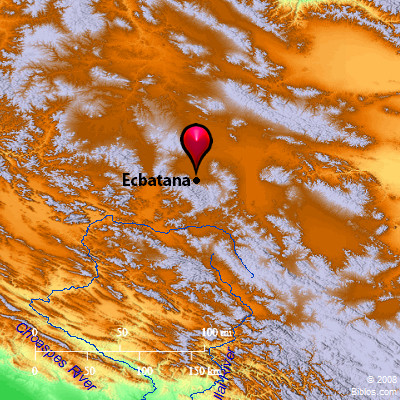Encyclopedia
ACHMETHAak'-me-tha (Ezra 6:2; 'achmetha'; Septuagint Amatha; Peshitta achmathan; in Tiglath Pileser's inscription circa 1100 B.C. Amadana: in Darius' Behistun Inscr., II, 76-78, Hangmatana = "Place of Assembly"; Agbatana, in Herodotus; Ekbatana, Xenophon, etc.; so 1 Esdras 6:23; Tobit 3:7; 6:05; 7:01; 14:12, 14; Judith 1:1, 2, 14; 2 Maccabees 9:3; Talmud hamdan; now hamadan).
1. Location:
This, the ancient capital of Media, stood (lat 34 degrees 50' North-long. 48 degrees 32' East) near the modern Hamadan, 160 miles West-Southwest of Tehran, almost 6,000 feet above the sea, circa 1 1/2 miles from the foot of Mt. Orontes (Alvand).
2. History:
It was founded or rebuilt by Deiokes (Dayaukku) about 700 B.C. on the site of Ellippi an ancient city of the Manda, and captured by Cyrus 549 B.C. who brought Croesus there as captive (Herodotus i.153). It was the capital of the 10th Nome under Darius I. Cyrus and other Persian kings used to spend the two summer months there yearly, owing to the comparative coolness of the climate. Herodotus describes it as a magnificent city fortified with seven concentric walls (i.98). Its citadel (biretha', Ezra 6:2, wrongly rendered "palace" in the Revised Version (British and American)) is mentioned by Arrian, who says that, when Alexander took the city in 324 B.C., he there stored his enormous booty. In it the royal archives were kept. It stood on a hill, where later was built a temple of Mithra. Polybius (x.27) speaks of the great strength of the citadel.
Though the city was unwalled in his time, he can hardly find words to express his admiration for it, especially for the magnificent royal palace, nearly 7 stadia in circumference, built of precious kinds of wood sheathed in plates of grid and silver. In the city was the shrine of Aine (Nanaea, Anahita?). Alexander is said to have destroyed a temple of AEsculapius (Mithra?) there. Diodorus tells us the city was 250 stadia in circumference. On Mt. Alvand (10, 728 feet) there have been found inscriptions of Xerxes. Doubtless Ecbatana was one of the "cities of the Medes" to which Israel was carried captive (2 Kings 17:6). It should be noted that Greek writers mention several other Ecbatanas. One of these, afterward called Gazaca (Takhti Sulaiman, a little South of Lake Urmi, lat. 36 degrees 28' North, long. 47 degrees 9' East) was capital of Atropatene. It was almost destroyed by the Mughuls in the 12th century. Sir H. Rawlinson identifies the Ecbatana of Tobit and Herodotus with this northern city. The southern and far more important Ecbatana which we have described is certainly that of 2 Maccabees 9:3. It was Cyrus' Median capital, and is doubtless that of Ezra 6:2. Classical writers spoke erroneously of Ecbatana (for Ecbatana) as moderns too often do of Hamadan for Hamadan.
3. Present Condition:
Hamadan has perhaps never fully recovered from the fearful massacre made there in 1220 A.D. by the Mongols, but its population is about 50,000, including a considerable number of descendants of the Israelites of the Dispersion (tracing descent from Asher, Naphtali, etc.). They point to the tombs of Esther and Mordecai in the neighborhood. It is a center for the caravan trade between Baghdad and Tehran. There is an American Presbyterian mission at work. Authorities (besides those quoted above): Ctesias, Curtius, Amm. Marcellinus, Pausanias, Strabo, Diod. Siculus; Ibnu'l Athir, Yaqut, Jahangusha, Jami`u't Tawarikh, and modern travelers.
W. St. Clair Tisdall
ECBAT'ANA, is the same as Ach'metha which name occurs only in Ezra 6:2, but in the margin called Ecbatana. It was in Media, 190 ms. nearly s. of the Caspian sea and 280 ms. n.e. of Babylon. Now called Hamadan. There is another Ecbatana, only ruins, 90 ms. s.w. from the Caspian, but not of present interest. Hamadan has about 30,000 in population and trades largely in leather.
ACHMETHA (pron. ak'me-tha), see Ecbat'ana.
Strong's Hebrew
H307: Achmethathe capital of Media




